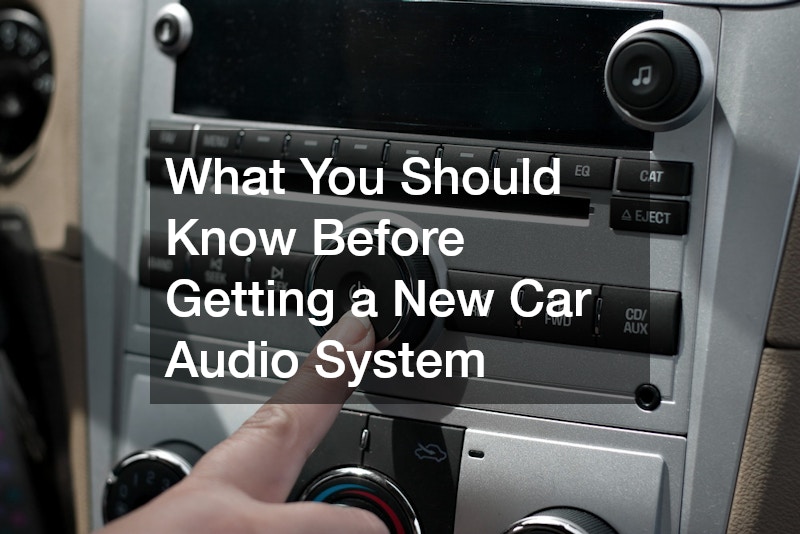
In this article, we'll explore everything you need to know before deciding to upgrade or install a new car audio system. With numerous options and technical details involved, it's crucial to arm yourself with the right knowledge to ensure satisfaction and avoid common pitfalls. We'll address the factors to consider, costs, and installation procedures.
Video Source
Understanding the basic elements that make up a car audio system is essential for providing optimal sound quality and performance. These components work together to create the audio experience in your vehicle, making it important to know how each one functions.
Speakers are perhaps the most crucial component of any car audio system. They are responsible for converting electrical signals into sound waves that we can hear. There are several types of speakers available, including coaxial and component speakers. Coaxial speakers offer an all-in-one solution with multiple drivers in a single unit, while component speakers separate the drivers, providing greater sound clarity and customization options.
The size and material of the speakers also play an important role in determining sound quality. Larger speakers can produce deeper bass, while different materials can affect the quality and durability of the sound output. For audiophiles, investing in higher-quality speakers can substantially improve the overall audio experience.
While selecting speakers, it's important to match them with the rest of the audio system components in terms of power handling and impedance to ensure they operate efficiently without distortion.
Amplifiers play a critical role in enhancing the audio system’s performance by boosting the audio signal’s power, enabling it to drive the speakers effectively. Without an amplifier, speakers would struggle to deliver high-quality sound, particularly at higher volumes. By providing the necessary power, amplifiers ensure clean and sharp sound output.
When choosing an amplifier, consider its power output, measured in watts, and its channels, which should correspond to the number of speakers in the system. For example, a four-channel amplifier could power a pair of front and rear speakers. Some audiophiles opt for mono amplifiers to power subwoofers separately.
It's essential to ensure that the amplifier's power output matches the speakers' capacity to avoid causing any damage due to overloading, ultimately ensuring a harmonious and powerful audio experience.
The head unit is the central control point of a car audio system. It serves as the interface through which you control the sound system, from adjusting volume and tuning radio stations to connecting external devices such as smartphones or USB drives. Modern head units often come equipped with advanced features such as touchscreen displays, GPS navigation, and compatibility with streaming services like Bluetooth.
When selecting a head unit, consider its compatibility with your vehicle and the features it offers. A high-quality head unit will significantly improve the usability and connectivity of your audio system, allowing for seamless integration with modern technology.
Ensure the head unit is compatible with your car's dashboard in terms of size and wiring configurations. Some may require a specialized adapter for installation, so it is prudent to verify compatibility before purchasing.
Entry-level audio systems are suitable for those seeking a basic upgrade from the factory default system without spending too much. These systems typically include basic speakers and a head unit that enhance sound quality from standard car setups. While not equipped with high-end features, entry-level systems can offer a noticeable improvement in audio performance.
The price range for entry-level systems can vary, but typically falls within a few hundred dollars. This price can fluctuate based on brand and additional features such as Bluetooth connectivity or integrated CD players. Generally, entry-level systems are a cost-effective way to enhance your driving experience without breaking the bank.
However, when opting for budget-friendly solutions, be cautious of drastically reduced prices as they may indicate compromised quality. It’s essential to balance affordability with quality to ensure longevity and satisfactory performance.
Mid-range car audio systems offer a balance between affordability and quality. They are typically favored by discerning buyers who desire superior sound quality without the high costs of top-tier systems. In this segment, you can expect enhanced features such as higher-quality speakers, better amplifiers, and head units with modern conveniences like digital sound processing.
The cost of mid-range audio systems typically ranges from several hundred to over a thousand dollars, depending on the specifications and brand. These systems promise better sound fidelity, deeper bass, and a more immersive audio experience compared to entry-level options.
Buyers considering mid-range options should evaluate the reviews and reputation of brands, as this can provide insight into the reliability and durability of the system components. With the right choice, mid-range systems can offer an excellent blend of performance and cost-effectiveness.
High-end car audio systems cater to audiophiles and those in pursuit of the ultimate audio experience. These systems come equipped with superior components offering unparalleled sound quality. Features such as advanced sound processing, top-tier materials for speakers, state-of-the-art amplifiers, and multi-functional head units contribute to a premium experience.
The investment required for high-end systems can be substantial, often running into several thousand dollars. While the cost may be prohibitive for some, the premium sound quality and advanced features make it a worthwhile investment for others.
High-end systems provide features like customizable equalizers, superior connectivity options, and professional-grade sound clarity. For tech-savvy users, these systems often integrate seamlessly with smartphones and digital assistants, enhancing both functionality and convenience.
Choosing a new car audio system involves understanding its various components, budgeting appropriately, and deciding on the most suitable installation approach. By considering these key aspects and aligning them with your personal preferences and needs, you can make an informed decision that enhances your driving experience with quality sound.
